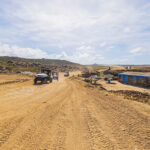Known as “One Happy Island,” Aruba is a tropical paradise located in the southern Caribbean Sea, just 15 miles north of Venezuela. This sun-soaked island is renowned for its white sandy beaches, turquoise waters, vibrant culture, and unique landscapes. Whether you’re an adventure seeker, a relaxation enthusiast, or a curious traveler, Aruba offers something for everyone. Here’s everything you need to know to make the most of your visit.
1. Geography and Climate
Aruba is a small island measuring approximately 21 miles long and 6 miles across at its widest point. Despite its compact size, it boasts diverse terrains ranging from pristine beaches on the western coast to rugged, cactus-filled landscapes in the east. The island’s constant trade winds provide a pleasant breeze, and with an average temperature of 82°F (28°C), Aruba is a year-round destination.
Notably, Aruba lies outside the hurricane belt, which means it’s less likely to experience extreme weather, making it a reliable choice for vacationers.
2. Beaches: A Paradise for Sun Seekers
Aruba’s beaches are among the best in the world. Here are a few you should not miss:
- Eagle Beach: Famous for its powdery white sand and iconic fofoti trees, Eagle Beach is ideal for relaxation and is frequently ranked as one of the top beaches globally.
- Palm Beach: Lined with luxury resorts, restaurants, and bars, Palm Beach is perfect for those seeking a lively atmosphere and water activities like jet skiing and parasailing.
- Baby Beach: A crescent-shaped lagoon with shallow, calm waters, Baby Beach is a favorite for families and snorkelers.
- Arashi Beach: Known for its crystal-clear waters and excellent snorkeling opportunities, Arashi Beach is quieter and more laid-back.
3. Adventure and Activities
Aruba offers plenty of opportunities for thrill-seekers and nature lovers:
- UTV and Jeep Tours: Explore the rugged terrains of the island, including the breathtaking Natural Pool, rugged cliffs, and hidden coves. Renting a UTV or Jeep allows you to access the less-explored areas.
- Snorkeling and Diving: Aruba’s coral reefs and shipwrecks, like the famous SS Antilla, are perfect for underwater adventures.
- Arikok National Park: This expansive park covers nearly 20% of the island and features hiking trails, limestone caves, and incredible views of the coastline.
- Windsurfing and Kiteboarding: Thanks to Aruba’s steady trade winds, the island is a hotspot for these exhilarating water sports.
- Horseback Riding: Enjoy scenic rides along the beach or through the island’s rugged interior.
4. Culture and Festivals
Aruba is a melting pot of cultures, influenced by its Dutch heritage and the diverse backgrounds of its residents. This cultural blend is reflected in the island’s vibrant music, dance, and culinary scene. Some cultural highlights include:
- Carnival: Held annually in January and February, Aruba’s Carnival features parades, music, and extravagant costumes.
- Bon Bini Festival: A weekly event showcasing traditional music, dance, and crafts.
- Local Cuisine: Savor dishes like keshi yena (stuffed cheese), pan bati (Aruban flatbread), and fresh seafood.
5. Accommodations and Dining
Aruba offers a range of accommodations to suit every budget, from luxury resorts and boutique hotels to budget-friendly guesthouses. Popular areas to stay include Palm Beach for its lively atmosphere and Eagle Beach for a more tranquil vibe.
For dining, Aruba’s culinary scene is as diverse as its culture. Indulge in local dishes at restaurants like Papiamento or Zeerovers, and explore international cuisine at high-end spots like The Flying Fishbone or Elements.
6. Practical Tips for Visitors
- Language: While the official languages are Dutch and Papiamento, English and Spanish are widely spoken.
- Currency: The Aruban Florin (AWG) is the official currency, but U.S. dollars are accepted almost everywhere.
- Transportation: Renting a car, UTV, or Jeep is the best way to explore the island. Public buses and taxis are also available.
- Safety: Aruba is one of the safest islands in the Caribbean, making it a great destination for solo travelers and families alike.
- Travel Documents: Most visitors need a valid passport to enter Aruba. Check visa requirements based on your nationality.
7. Sustainable Tourism
Aruba is committed to preserving its natural beauty. As a visitor, you can contribute by:
- Respecting wildlife and natural areas.
- Avoiding single-use plastics and using reef-safe sunscreen.
- Supporting local businesses and eco-friendly tours.
8. Top Attractions You Shouldn’t Miss
- California Lighthouse: Offers stunning panoramic views of the island.
- Alto Vista Chapel: A picturesque chapel with historical significance.
- Butterfly Farm: A peaceful sanctuary where you can learn about various butterfly species.
- Natural Bridge: Though the original collapsed, smaller natural bridges are still a marvel to see.
- Oranjestad: The capital city is a hub for shopping, dining, and exploring colorful colonial architecture.
Why Visit Aruba?
Aruba’s perfect blend of natural beauty, rich culture, and welcoming hospitality makes it an unforgettable destination. Whether you’re basking on pristine beaches, exploring off-the-beaten-path trails, or immersing yourself in local traditions, Aruba promises an experience filled with joy and discovery.
So pack your bags, embrace the island’s laid-back vibe, and get ready for an adventure of a lifetime in Aruba — where happiness lives!




